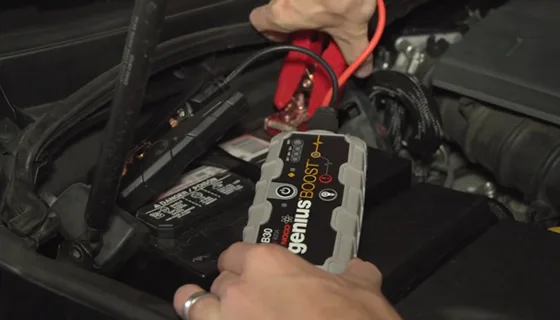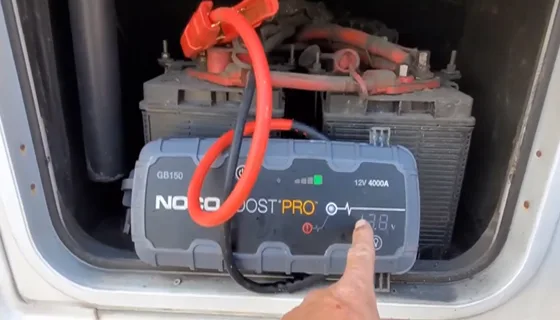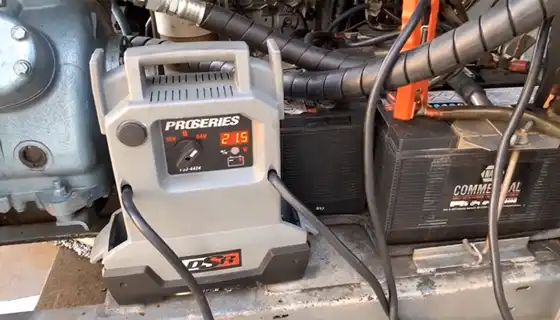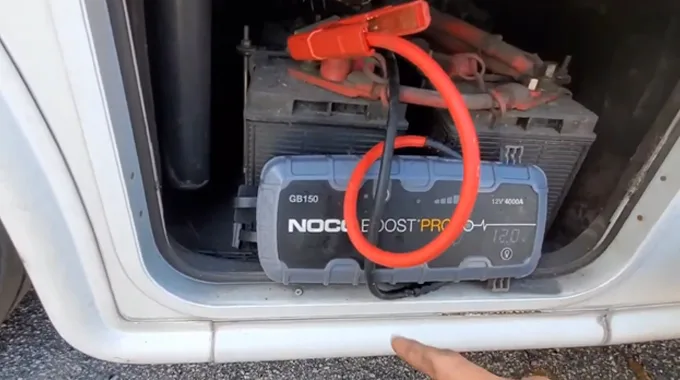Last Updated on May 1, 2023
As any RVer knows, a Battery Boost can be a lifesaver when traveling. Not only does it provide an extra boost of power when needed, but it also helps to prolong the life of your RV battery. A Battery Boost can be especially helpful when traveling in remote areas where there is no hookup available.
If you want to know about how to use battery boost on RV, then first you have to know about the boost mechanism. The mechanism is very simple. A solenoid connects the main batteries in parallel with the chassis battery (the engine).
Aux/Boost’s switch is momentary, meaning it only holds the solenoid engaged while the boost switch is being pressed down. Still, there are a few things that you need to keep in mind when using a battery boost on your travel trailer. That is why we have put together this quick guide so you can get your RV back on the road quickly.
Guidelines on How to Use Battery Boost on RV

We will go over some general guidelines that will help you use a battery boost on your RV. After all, using a battery boost is not something that you do every day. So, it is important to understand how it works and what you need to do to properly use it.
Step 01: Preparation is Key
Before using a battery boost, you should read the instructions that come with it carefully. Many RV batteries are located in hard-to-reach places, so you need to know how to safely and correctly use the battery boost. With a little bit of care and attention, a battery boost button can be a helpful tool for getting your RV started.
When using the battery boost, be sure to hold the clamps securely in place and not touch the metal parts of the clamps together. Doing so could cause an electrical shock. If you are not comfortable using the battery boost button, ask a friend or family member for help.
Step 02: Don’t Forget to Charge
Make sure that the battery boost is properly charged. Once it is, connect the positive and negative terminals of the boost to the corresponding terminals on your RV’s battery. Then, press and hold the boost button for three to five seconds.
This should provide enough power to start your engine. Of course, you’ll want to get your RV’s battery checked and replaced if necessary as soon as possible to avoid future problems. But in a pinch, the battery boost can be a real lifesaver.
Step 03: Implementation
Assuming your RV has a 12-volt battery, the first thing you’ll need to do is connect the positive terminal of the battery boost to the positive terminal of the RV’s battery.
Next, connect the negative terminal to a metal ground on the RV. Once the battery boost is connected, you should see the voltmeter on the boost jump up to around 12.6 volts.
At this point, you can start your RV’s engine and let it run for a few minutes to recharge the battery. Finally, disconnect the battery boost and stow it away until you need it again. Thanks to the battery boost, you’ll be able to start your RV even if your battery is completely drained.
What to do if your RV doesn’t start with the Battery Boost

If your recreational vehicle (RV) won’t start with the battery boost, there are a few things you can do to troubleshoot the issue.
- Check the connections to make sure the booster cables are properly connected to the battery. If they appear to be loose or damaged, try reconnecting them.
- If the problem persists, it’s possible that the battery is not receiving enough power. Using a voltmeter, check the voltage at the battery terminals after starting the RV’s engine. If the voltage is low, it’s likely that the battery bank needs to be replaced.
- If none of these solutions work, it’s possible that there is an issue with the RV’s electrical system. In this case, it’s best to consult a qualified RV technician for further diagnosis and repairs.
How to Maintain Your Battery Boost System
A battery boost system is a great way to ensure that your car always has enough power. By keeping your battery boosted, you can avoid the hassle of having to jump-start your car or replace your battery. It is important to maintain your battery boost system so that it continues to work properly. Here are a few tips:
- Check the level of the electrolyte solution regularly and top it up if necessary.
- Keep the terminals clean and free of corrosion.
- Make sure the jumper cables are in good condition and properly connected
By following these simple tips, you can keep your battery boost system working properly and avoid problems down the road.
What is the Battery Boost Button on RVs for

RVs are equipped with a number of buttons and switches that perform different functions, and it can be easy to forget what each one does. The battery boost button, for example, is a simple but essential feature.
Its purpose is to provide a quick burst of power to the RV battery, which can be helpful if the battery is running low or if you need to start the engine.
The battery boost is typically located near the RV’s main power panel, and it is usually clearly labeled. To use it, simply press and hold the button for a few seconds. Know where and how to use it if you need to boost your RV’s battery when it runs low.
FAQs
Here are answers to some common questions about battery boost systems:
How long does it take to charge a dead RV battery?
If it is below 50% capacity, it will take 8 hrs or more to charge using your stock RV converter. You can upgrade to a 4-stage smart battery charger to charge faster, but this will usually only recharge your dead battery in around 2 hours.
Make sure to keep your RV plugged into shore power as much as possible during the charging process to ensure that your battery gets enough juice. Finally, once your RV house battery is charged, be sure to drive your RV around for at least 30 minutes to help distribute the charge evenly throughout the system.
Why do RV batteries go dead?
There are several reasons why RV batteries may go dead prematurely. One common cause is sulfation, which occurs when sulfate crystals build up on the lead plates in the battery. This can happen if the battery is not used for long periods of time, or if it is regularly subjected to deep discharge cycles.
Another common cause of battery death is parasitic loads, which occur when electrical devices draw power from the battery even when they are turned off. These devices can include anything from computers to televisions, and they can quickly drain a battery if they are not unplugged when not in use.
Self-discharging is another major cause of premature battery death. This occurs when a battery slowly loses its charge over time, even when it is not being used. This can happen due to Manufacturing defects, damaged cells, or simply old age. Also, lack of maintenance, overcharging, and extreme temperatures can all contribute to self-discharging.
How long does a pop up camper battery last?
A correctly maintained solar panel deep cycle battery can have a lifespan of 6 years or more. Some RV owners replace their batteries every year or two. Extending the life of your coach batteries is not difficult, it just requires some basic care and maintenance.
By following a few easy tips, it is possible to keep batteries healthy for years to come. First, make sure to keep them clean and free of dirt and debris. Second, avoid overcharging or deep discharge, as this can damage the battery cells. Finally, check the fluid levels regularly and add distilled water if needed. By following these guidelines, you can help ensure that your RV batteries will last for years to come.
Last Words
We hope you enjoyed this article on how to use battery boost on an RV. Whether you are a full-time RVer or a weekend warrior, you’ve got to keep your RV battery charged. By following the tips in this article, you can extend the life of your multiple batteries and avoid costly repairs down the road.
RV batteries are essential for powering your lights, fridge, water pump, and other vital systems. And while they’re built to last, they need to be properly maintained to reach their full lifespan. Luckily, it’s not difficult to keep your RV batteries in tip-top shape, just follow the tips in this article!
Thanks for reading, and we hope this article was helpful. Do you have any tips for maintaining RV batteries? Share them in the comments below.



